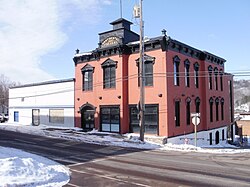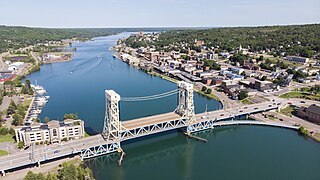
Houghton is the largest city and county seat of Houghton County in the U.S. state of Michigan. Located on the Keweenaw Peninsula, Houghton is the largest city in the Copper Country region. It is the fifth-largest city in the Upper Peninsula, with a population of 8,386 at the 2020 census. Houghton is the principal city of the Houghton micropolitan area, which includes all of Houghton and Keweenaw counties. Houghton lies upon the Keweenaw Waterway, a partly natural, partly artificial waterway connecting at both ends to Lake Superior. Across the waterway from Houghton lies the city of Hancock.
Dreamland is an unincorporated community on Copper Island, in Torch Lake Township, Houghton County, in the Upper Peninsula of the U.S. state of Michigan. It has been described as being a "district of Bootjack" or in Bootjack, but it is a separate town. The town consists almost entirely of the Dreamland Inn and some docks on Torch Bay.

Hancock is a city in the Upper Peninsula of the U.S. state of Michigan. The population of Hancock was 4,501 at the 2020 census. The city is located within Houghton County, and is situated upon the Keweenaw Waterway, a channel of Lake Superior that cuts across the Keweenaw Peninsula. Hancock is located across the Keweenaw Waterway from the city of Houghton, and is connected to that city by the Portage Lake Lift Bridge. The city is located within Michigan's Copper Country region.

Houghton County is a county in the Upper Peninsula in the U.S. state of Michigan. As of the 2020 Census, the population was 37,361. The county seat and largest city is Houghton. Both the county and the city were named for Michigan State geologist and Detroit Mayor Douglass Houghton.
Dakota Heights is an unincorporated community in Portage Charter Township, Houghton County in the U.S. state of Michigan. It is an enclave surrounded on all four sides by the extreme western part of the city of Houghton ; it is non-contiguous with any other part of Portage Township. Living in Dakota Heights is at least sometimes regarded as living "in town" (Houghton).

Ransom Bird Shelden Sr. was the founder of Houghton, a city in the county of Houghton County, Michigan.

Dee Stadium, also called The Dee, is an ice hockey arena in Houghton, Michigan, that replaced, and is located on the same site as, the Amphidrome. It is regarded as the birthplace of professional hockey, and is the seventh oldest indoor ice rink in the world.
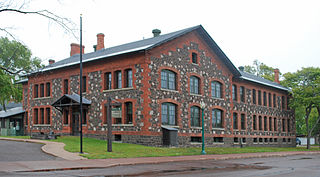
Keweenaw National Historical Park is a unit of the U.S. National Park Service. Established in 1992, the park celebrates the life and history of the Keweenaw Peninsula in the Upper Peninsula of the U.S. state of Michigan. As of 2009, it is a partly privatized park made up of two primary units, the Calumet Unit and the Quincy Unit, and 21 cooperating "Heritage Sites" located on federal, state, and privately owned land in and around the Keweenaw Peninsula. The National Park Service owns approximately 1,700 acres (690 ha) in the Calumet and Quincy Units. Units are located in Baraga, Houghton, Keweenaw, and Ontonagon counties.
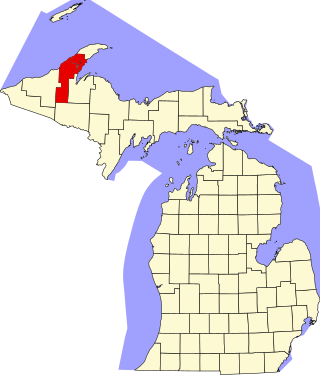
This is a list of the National Register of Historic Places listings in Houghton County, Michigan.

The A.E. Seaman Mineral Museum, currently located on the campus of Michigan Technological University in Houghton, Michigan, is the official mineral museum of the state of Michigan and is a heritage site of the Keweenaw National Historical Park. The museum is named for professor Arthur Edmund Seaman, who worked at Michigan Tech in the late 19th and early 20th centuries, and was the museum's curator from 1928 until 1937.

The Calumet and Hecla Industrial District is a historic district located in Calumet, Michigan and roughly bounded by Hecla & Torch Lake Railroad tracks, Calumet Avenue, Mine and Depot Streets. The district contains structures associated with the copper mines worked by the Calumet and Hecla Mining Company, located along a line above the copper lode, where railroad tracks connected separate mine heads. The Historic District is completely contained in the Calumet Historic District and the Keweenaw National Historical Park. It was designated a Michigan State Historic Site in 1973 and was listed on the National Register of Historic Places in 1974.

The Ransom B. Shelden House is a private house located at 1304 College Avenue in Houghton, Michigan. It is currently used as the Tau Kappa Epsilon (ΤΚΕ) Fraternity House. The house was listed on the National Register of Historic Places in 1980.
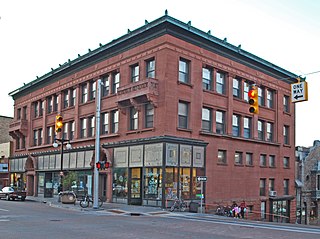
The Shelden-Dee Block is a commercial building located on the corner of Shelden Avenue and Isle Royale Street in Houghton, Michigan. The building was listed on the National Register of Historic Places in 1980.

The Shelden Avenue Historic District is a commercial historic district located along Shelden, Lake, & Montezuma Avenues in Houghton, Michigan. The district contains 43 contributing buildings in an area of 22 acres. It was listed on the National Register of Historic Places in 1987.

The Quincy Smelter, also known as the Quincy Smelting Works, is a former copper smelter located on the north side of the Keweenaw Waterway in Ripley, Michigan. It is a contributing property of the Quincy Mining Company Historic District, a National Historic Landmark District. The smelter was built in 1898 by the Quincy Mining Company, operating from 1898 to 1931 and again from 1948 to 1971. The smelter was part of a Superfund site from 1986 to 2013.
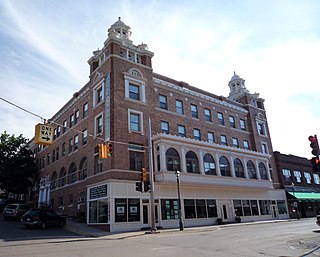
The Douglass House is a hotel located at the corner of Shelden Avenue and Isle Royale Street in Houghton, Michigan. It was placed on the National Register of Historic Places in 1982.

Michigan Technological University's campus sits on 925 acres on a bluff overlooking Portage Lake.

The Carnegie Museum of the Keweenaw in Houghton, Michigan, is a non-collecting museum that houses changing exhibits about local cultural and natural history.

Trinity Episcopal Church is a Gothic Revival-style Episcopal church at 205 East Montezuma Avenue in Houghton, Michigan. It was designated a Michigan State Historic Site on July 17, 1986. It is the second of two church buildings to exist on the site; the current one replaced a wooden structure in 1910. The church's philosophy is built on the Oxford Movement.
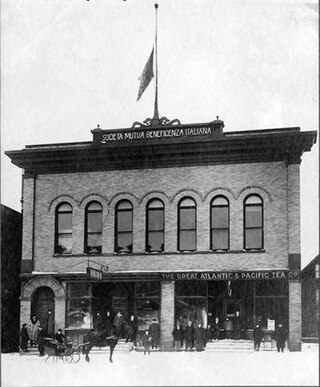
Italian Hall was a two-story commercial and recreational building in Calumet, Michigan, built in 1908 and demolished in 1984. Two prior buildings known popularly as "Italian Hall" had stood on the site. The first floor housed commercial space with a large hall on the second floor. The building served as headquarters for the Società Mutua Beneficenza Italiana and hosted community events. The hall is notorious as the site of a disaster in 1913 in which over 70 people died after a false cry of "fire" at a Christmas party. Since demolition, the site has served as a memorial park. The property is a Michigan State Historic Site and the building was formerly on the National Register of Historic Places.
